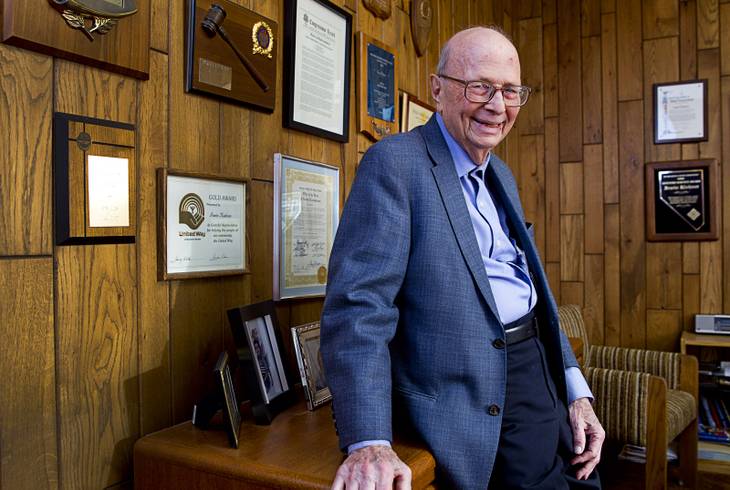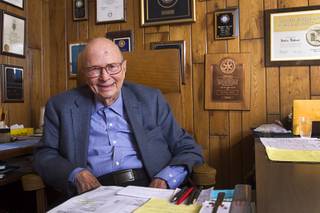Real estate investors streamed in and out of the north Strip this past decade, imploding casinos, breaking ground on new ones and drawing up plans for other supersized projects.
Most ideas failed, saddling the area with empty land, partially built resorts and thin foot traffic. But through it all, in a boom-and-bust town with no qualms about dynamiting its past, one developer and his decades-old properties remain anchored to the neighborhood.
Irwin Kishner owns more than 8 acres off Las Vegas Boulevard and Convention Center Drive. His '60s-era developments, along Kishner Drive, include Somerset Shopping Center, apartment buildings and a vacant lot where Somerset House Motel once stood. He tore that property down about five years ago, he said, because it was not “economically productive.”
“Money was going out, not going in,” he says.
An 82-year-old East Coast transplant, Kishner has lived in Las Vegas since the mob and Rat Pack days, dated a showgirl and watched the resort corridor and the valley explode in growth.
He also cashed in on the bubble years, selling his holdings along Kishner Drive for $100 million to conglomerate Triple Five in March 2008. Five months later, with the economy sliding, he reacquired the properties, Clark County records show. Kishner said he made $15 million on the deal anyway.
He works from an office in the mostly empty Somerset Shopping Center, near the partially built, 68-story Fontainebleau resort, which has sat untouched for years but now is up for sale. He’s also near the shuttered Riviera, which is slated to be demolished for a Las Vegas Convention Center expansion project; the planned Resorts World Las Vegas; and the vacant site where the Clarion hotel, imploded in February, stood.
Resorts World, a $4 billion Chinese-themed megaresort, is being built at the site of the once-abandoned Echelon casino project, but construction appears to be slow-going.
Kishner recently sat down with the Sun to talk about his background, career, and adopted city, and the changes he’s seen. Edited excerpts:
• • •
I was born in Brooklyn, N.Y., Brighton Beach, in 1933. I was a Depression baby. I lived in Brooklyn until age 13, when we moved to Florida because of my father’s health. He couldn’t take the winters. My father was a builder, a contractor; he built our home. Before I was born, he was fairly wealthy. He lost just about everything in the Depression. I never had to worry about a meal, but I had hand-me-down-clothes from my older brother. Before we moved, my dad used to go to Florida every year for the winter. My mom didn’t go; she stayed home and took care of the business. I used to go to the bank with her. We ate at a Chinese restaurant you could see from the train; 55 cents for a fantastic lunch. I loved those trips.
• • •
We moved to Florida in 1946, to Miami Beach. My first experience when I got there was a hurricane. We were in this beachfront hotel — not a fancy one, but a nice one — and the water was about a foot-and-a-half deep in the lobby. After high school, I went to the University of Florida in Gainesville. The southern part of Florida is mostly transplanted New Yorkers and others; up there, you’re going into Klan country. I got into everything at that school — publications, athletics, student government. I got my bachelor’s in 1954 and started law school there.
• • •
My father died in 1955. He was actually out here in Las Vegas with my mother when he died. My parents drove here from Florida to visit some family. They were in the car, waiting for my uncle to come out of his condo so they could go to Hoover Dam. My mother turned her head, then turned back, and my father was gone. Just boom, like that. He had a heart attack. So I had to come from Florida, all the way out here, to bring my mother back and the body back to bury him. He was on the same plane as me. It was quite an experience.
• • •
It was the first time I had been to Vegas. I had this grand-uncle, who I ended up working for, trying to take me around, but I had just lost my father. My mother was a wreck. They had been married for 30 or 40 years. My father’s name was Samuel. My mother’s name was Ida.
• • •
I had to transfer schools because my mother was alone. She was in Miami Beach in the house my father built. I transferred to the University of Miami law school and moved back home. Later, I got a job with an attorney who represented second-mortgage companies. I examined abstracts — chains of title. I worked in a small office. He was a tremendous guy, but I couldn’t take it. I stayed there until I got into a car accident. I came to my senses; this was not a life for me. I was kind of bored with the work. I was an active person. I needed the stimulation.
• • •
I moved to Las Vegas in 1960. I had family here, and I also had a small stake in land here. I actually had mortgaged my mother’s house and we invested the money with my uncle — he gave my brother, myself and my mother an interest in a piece of property near the Riviera. I didn’t have a covered wagon, but moving here was my pioneer adventure. My family had built the Blair House, on Desert Inn Road. I lived there for a year. I had no money. I worked for my grand-uncle and got $50 a week. I helped him build the Gold Key motel, across from the Frontier.
• • •
I became friends with a former boxing champion, Jackie Fields, who worked in the Sands hotel in the Copa lounge. I ended up getting fixed up with a Copa gal, a dancer. She had been involved with some mobsters and was in some movies. I would work from 5:30, 6 o’clock in the morning, get some sleep, pick her up between shows around 9 o’clock, take her to Louigi’s, this famous Italian gathering spot, go back home, go to sleep, come back after she had to contractually mingle with the guests in the lounge, then go out with her afterward. She was my so-called girlfriend. We would go down to Fremont, to the movie theater. Some of the guys I knew would see me there, with this blonde with a beehive. “Kishner?!”
• • •
The first property I developed as an owner was Somerset Apartments on Kishner Drive. We built everything on the street that exists today. Somerset Apartments opened in 1961. My uncle and I developed it. After that, we built Somerset House Motel, which opened in 1962, then we opened the Somerset Gardens apartment complex in 1963 and Somerset Shopping Center in 1966. Somerset is an area of England. It’s catchy.
• • •
It’s a cliché to say Vegas was better in the mob days. You didn’t have all the restrictions back then; you had dealers, waitresses who didn’t declare their income, the whole bit. It was open territory. The Cleveland mob, the Detroit mob — Cleveland was the primary one here. You knew what was going on. If you didn’t know, you were stupid. Some people got indicted, some didn’t. Believe me, I never got a pay-off or anything. If you ask anybody in town, some might say I’m a bastard, I’m tough, this or that, but I’m honest. I’ve never cheated anybody and I’ve never lied to anybody. I never wanted to worry about the IRS or anything. Was I a goodie-goodie? No. But if you had to deal with me and sign a contract, you know it’s good. My late father was as honest as anyone, but in New York, the inspectors came in for their weekly check. It was the way of doing business. It was a common thing. Some of that was here. These type of people are all over; they take advantage of their position and get paid off.
• • •
The old hotels were good in their day, but they didn’t have a lasting — the Thunderbird was so outdated. It didn’t have the facilities, decent shopping. In the old days, casinos didn’t have as much competition. They survived on connections, on junkets.
• • •
What they originally planned for the Stardust property, the Echelon, would have been a fantastic addition. It would have definitely given the north end of the Strip a shot in the arm. The SLS is struggling, but not because the area is dead. The “new kid on the block” theory doesn’t work, unless you’ve got something so grandiose that it will take away from everything. You don’t have that. But what’s going on with the Echelon now, with the Asian-themed project? I hear every damnedest story. Everyone’s got a theory. Does somebody really know? They haven’t done much. I don’t hear any movement. The north Strip isn’t dead, but it’s dormant. There are so many other attractions on the Strip. Why go to an area that’s antiquated?
• • •
With the Clarion, all I can tell you is this. Everyone has their ideas of glory. They’re speculating. A gambler rolls the dice; what are the actual odds, scientifically, that you end up with a seven?
• • •
I sold everything on the street here to Triple Five for about $12 million an acre. We had it deeded back to us, free and clear. I kept a $15 million nonrefundable deposit. It’s a matter of record; I’m not telling you something secret. The sale would have helped this whole area. They were very honest and up-front, but their credit dried up. All the banks went kaput. They had no choice.
• • •
I have no plans to retire at this point; I’ll keep working until I go to the happy hunting ground. We’re not breaking up the street, either; it will be sold as a complete package. I sold Somerset Apartments several years ago, and the owners have agreed to sell at the same time as me. It all has more value as a package than as individuals.
• • •
The north Strip has progressed somewhat, but not enough. It has not reached its potential in any way, shape or form. It will get better, no question about it. But I don’t think anyone knows how soon. Maybe five years down the road. It has to. It can’t stay like this.

